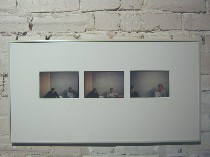
There’s still lots of stuff I meant to see last week but didn’t. Typical.
But I saw a couple of group shows that were worthy of mention. On First Friday, Roberta and I both went to MBN Studios/freeform gallery, because our friend Ditta Baron Hoeber was part of a 9-person show curated by freeform’s Tadashi Moriyama.
The show focuses on the diaristic and time-oriented role of serial images in art, with implicit comparisons between photos and video and paintings.
Although Hoeber is of a different generation–i.e. mine–than the rest of the artists (young, mostly recent graduates), her work seems in tune with theirs–a horizontal line of small serial photographs focusing on the empty spaces between people who are sitting around rehearsing a play. She also offered drawings of some of the actors and some contact-sheet-size prints as well. The line-up promises action, yet the people are pretty static, only their heads swivelling a little on their necks. The heads appear at the edges of the photos, falling off the bottom, barely in sight. I think it’s better not to know this is a rehearsal. Then the images have a mystery that goes beyond the surprising compositions (left, from Hoeber’s “Ensemble”).
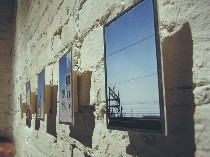 Rosi Dispensa’s five images of Northern Liberties (really, just five in eight months?) are the size of picture postcards, but the content is not picture-postcard material, except for the intense blue skies. The gritty street and infrastructure details appear to float in front of the skies. And the pictures float in front of the wall, pristine presentations edged in aluminum and hung on wooden-block spacers with nice hardware and then leveled with delicate cork washers–hardware chic meets the real city, the part of the city that’s never advertised. The work captures the mundane neighborhood in mundane images that glow (right, Dispensa’s series, the closest one, “Wires”).
Rosi Dispensa’s five images of Northern Liberties (really, just five in eight months?) are the size of picture postcards, but the content is not picture-postcard material, except for the intense blue skies. The gritty street and infrastructure details appear to float in front of the skies. And the pictures float in front of the wall, pristine presentations edged in aluminum and hung on wooden-block spacers with nice hardware and then leveled with delicate cork washers–hardware chic meets the real city, the part of the city that’s never advertised. The work captures the mundane neighborhood in mundane images that glow (right, Dispensa’s series, the closest one, “Wires”).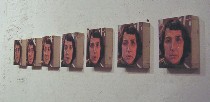 Michael Sullivan’s set of six paintings are of a woman saying, Thank you. They are painted from stills of a video of her speaking, but Sullivan adds oomph and detail, punching up the flat and blurred image from the video still. These are swell and intense, the shifting expression almost creepy. Sullivan was included in “The New Acropolis” at Fleisher-Ollman and “Salon: Possibilities in Painting” at the Optimistic (see our posts on “Salon” here and here). (left, “Thank you”)
Michael Sullivan’s set of six paintings are of a woman saying, Thank you. They are painted from stills of a video of her speaking, but Sullivan adds oomph and detail, punching up the flat and blurred image from the video still. These are swell and intense, the shifting expression almost creepy. Sullivan was included in “The New Acropolis” at Fleisher-Ollman and “Salon: Possibilities in Painting” at the Optimistic (see our posts on “Salon” here and here). (left, “Thank you”)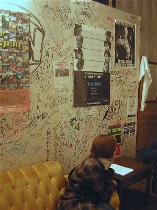 Mokomoko’s installation of a fan’s worshipful shrine– in which Mokomoko is the fan, the star in the posters, and the artist of the posters–seems like a sign of the times. She bases it on her diaristic webpage, which creates a Mokomoko for public consumption that dwells somewhere between fact and fiction and fantasy. I’m put in mind of Paul Simon’s lyrics, “the camera follows us in slo mo, the way it looks to us all.” There’s something about the Web and blogs and Web pages in which everyone is their own star.”THE MOKOSPACE-Movie Posters of my life,” with its grafitti-covered walls, is a frenetic translation of cyber into real space (right, a detail of “THE MOKOSPACE,” with “movie posters”).
Mokomoko’s installation of a fan’s worshipful shrine– in which Mokomoko is the fan, the star in the posters, and the artist of the posters–seems like a sign of the times. She bases it on her diaristic webpage, which creates a Mokomoko for public consumption that dwells somewhere between fact and fiction and fantasy. I’m put in mind of Paul Simon’s lyrics, “the camera follows us in slo mo, the way it looks to us all.” There’s something about the Web and blogs and Web pages in which everyone is their own star.”THE MOKOSPACE-Movie Posters of my life,” with its grafitti-covered walls, is a frenetic translation of cyber into real space (right, a detail of “THE MOKOSPACE,” with “movie posters”).Others in the show are Kristofer Harzinski, with gridded photos of minutiae, showing entropy’s effects on an abandoned airport; William Medearis, with a grid of 27 similar paintings; Ryoichi Asada, with gelatin silver prints; and Osamu Kushida, with photos of moving bodies as blots with auras.
(This is a tough gallery to get into when it’s not First Friday, so call before you go).
The group show of emerging artists at Artists House was at the other end of the spectrum, representational painting with a lot of trompe l’oeil technique. But three of the artists there caught my eye, each for different reasons.
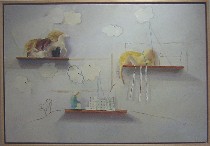 Sarah Hunter, a Pennsylvania Academy of the Fine Arts alum, paints some mighty odd paintings of mighty odd still life groupings–rough little assemblages that include crudely cut-out and painted fish or clouds, shelves supported by embroidery silk threaded through sewing-card holes, tschotchkes like toy ponies and religious figures, marked up masking tape and so on. The magic is capturing these anti-traditional images with trompe l’oeil technique (left, “Apocalyptic Vision”).
Sarah Hunter, a Pennsylvania Academy of the Fine Arts alum, paints some mighty odd paintings of mighty odd still life groupings–rough little assemblages that include crudely cut-out and painted fish or clouds, shelves supported by embroidery silk threaded through sewing-card holes, tschotchkes like toy ponies and religious figures, marked up masking tape and so on. The magic is capturing these anti-traditional images with trompe l’oeil technique (left, “Apocalyptic Vision”). 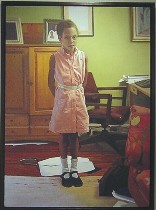 University of the Arts alum Jas Knight’s trompe l’oeil technique is brilliant. The drops of water on bathroom tiles with soiled grout practically bead on the surface of the canvas. A portrait of a young girl in a pink dress, with its luminous greens in the background and on the girl’s face, is luscious and beautiful. The subject is a sweet young African American girl in her Mary Janes, not the Infanta or the blue boy. Another painting includes a backpack gaping open. The merger of daily life with a technique usually reserved for still life is a surprise in this day and age (“Girl in a Pink Dress,” right).
University of the Arts alum Jas Knight’s trompe l’oeil technique is brilliant. The drops of water on bathroom tiles with soiled grout practically bead on the surface of the canvas. A portrait of a young girl in a pink dress, with its luminous greens in the background and on the girl’s face, is luscious and beautiful. The subject is a sweet young African American girl in her Mary Janes, not the Infanta or the blue boy. Another painting includes a backpack gaping open. The merger of daily life with a technique usually reserved for still life is a surprise in this day and age (“Girl in a Pink Dress,” right).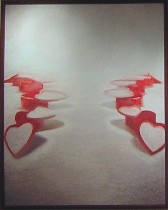
And Michael de Luca, a CAN artist, I mean CFEVA artist, who teaches at Arcadia, paints light transforming the ordinary into an object of desire. His “Love Painting III” (left) turns multiple heart-shaped boxes into glowing, consumable, juicy objects that call up desire of many kinds. His chair draped in a flowered cloth or sheet that forms a train on the floor becomes a glowing throne. Even a pile of cinder blocks–not as original a subject–take on some desirability. de Luca’s brush strokes are as material and sexy as his subject matter.
Others in the show are Hellen Cha-Kim, Holly DeCovny, Frank Kallop, Denise Lewandowski, Carol Maguire, Laura Renner, Alanna Rose, Sterling Shaw, Daria Zolotareva and Gregory Watson.
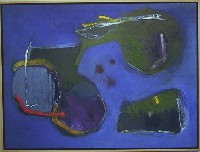 Marjorie Grigonis, who is a friend of ours, has a show across the street at 3rd Street Gallery. She’s got some new wrinkles in her work–densely colored backgrounds instead of the usual white, and a couple of collaged paper pieces (right, “Berber”). Grigonis said she thought the colors were inspired by a trip to North Africa.
Marjorie Grigonis, who is a friend of ours, has a show across the street at 3rd Street Gallery. She’s got some new wrinkles in her work–densely colored backgrounds instead of the usual white, and a couple of collaged paper pieces (right, “Berber”). Grigonis said she thought the colors were inspired by a trip to North Africa.









